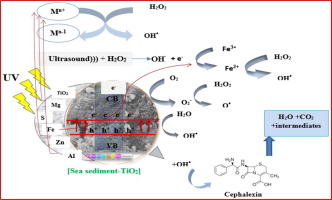当前位置:
X-MOL 学术
›
Ultrason. Sonochem.
›
论文详情
Our official English website, www.x-mol.net, welcomes your feedback! (Note: you will need to create a separate account there.)
Design a new photocatalyst of sea sediment/titanate to remove cephalexin antibiotic from aqueous media in the presence of sonication/ultraviolet/hydrogen peroxide: Pathway and mechanism for degradation.
Ultrasonics Sonochemistry ( IF 8.4 ) Pub Date : 2020-03-09 , DOI: 10.1016/j.ultsonch.2020.105062 Fatemeh Tavasol 1 , Taybeh Tabatabaie 1 , Bahman Ramavandi 2 , Fazel Amiri 1
Ultrasonics Sonochemistry ( IF 8.4 ) Pub Date : 2020-03-09 , DOI: 10.1016/j.ultsonch.2020.105062 Fatemeh Tavasol 1 , Taybeh Tabatabaie 1 , Bahman Ramavandi 2 , Fazel Amiri 1
Affiliation

|
The aim of the current study was directed to develop a new sea sediment/titanate photocatalyst to remove cephalexin from aqueous media in the presence of ultraviolet (UV) light, hydrogen peroxide (H2O2), and ultrasonic waves. The influence of furnace temperature (300, 350, 400, and 500 °C), furnace residence time (1, 2, 3, and 4 h), and ratio of sea sediment: titanium (0-6 v: w) on the physicochemical properties and the cephalexin removal by the sea sediment/titanate photocatalyst was explored. The technique of FTIR, SEM/EDX, XRD, BET, BJH, and Mapping was used to determine the physicochemical properties of the generated photocatalyst. The maximum cephalexin removal (94.71%) was obtained at the furnace temperature of 500 °C, the furnace residence time of 2 h, and the sea sediment: titanium ratio of 1:6 (=12 mL TiO2/2 g sea sediment). According to the acquired results, the surface area of the optimized catalyst, namely Cat-500-2-12, was computed to be 52.29 m2/g. The crystallite size of titanium oxide on the optimum photocatalyst was calculated ~17.68 nm. The FTIR test confirmed the presence of C=C, O-H, C=O, C-S, and C-H functional groups in the photocatalyst. The transformation pathway for the degradation of cephalexin by the developed system was drawn. The present investigation showed that the developed technique (sea sediment/titanate-UV-H2O2-ultrasonic) could be used as a promising alternative for attenuating cephalexin from aqueous solutions.
中文翻译:

设计一种新的海洋沉积物/钛酸盐光催化剂,在超声/紫外线/过氧化氢存在下,从水性介质中去除头孢氨苄抗生素:降解途径和机理。
当前研究的目的是开发一种新型的海洋沉积物/钛酸盐光催化剂,以在存在紫外线(UV),过氧化氢(H2O2)和超声波的情况下从水性介质中去除头孢氨苄。熔炉温度(300、350、400和500°C),熔炉停留时间(1、2、3和4 h)以及海沉物:钛的比例(0-6 v:w)对熔炉温度的影响研究了海洋沉积物/钛酸盐光催化剂的理化性质和对头孢氨苄的去除作用。使用FTIR,SEM / EDX,XRD,BET,BJH和Mapping技术确定生成的光催化剂的物理化学性质。在炉温为500°C,炉膛停留时间为2 h,海沉积物与钛之比为1:6(= 12 mL TiO2 / 2 g海沉积物)的情况下,最大的头孢氨苄清除率达到了94.71%。根据获得的结果,优化催化剂Cat-500-2-12的表面积计算为52.29 m2 / g。计算出最佳光催化剂上二氧化钛的微晶尺寸为〜17.68 nm。FTIR测试证实了光催化剂中存在C = C,OH,C = O,CS和CH官能团。绘制了该系统降解头孢氨苄的转化途径。目前的研究表明,所开发的技术(海洋沉积物/钛酸盐-UV-H2O2-超声波)可以用作从水溶液中减轻头孢氨苄的有前途的替代方法。FTIR测试证实了光催化剂中存在C = C,OH,C = O,CS和CH官能团。绘制了该系统降解头孢氨苄的转化途径。目前的研究表明,所开发的技术(海洋沉积物/钛酸盐-UV-H2O2-超声波)可以用作从水溶液中减轻头孢氨苄的有前途的替代方法。FTIR测试证实了光催化剂中存在C = C,OH,C = O,CS和CH官能团。绘制了该系统降解头孢氨苄的转化途径。目前的研究表明,所开发的技术(海洋沉积物/钛酸盐-UV-H2O2-超声波)可以用作从水溶液中减轻头孢氨苄的有前途的替代方法。
更新日期:2020-03-09
中文翻译:

设计一种新的海洋沉积物/钛酸盐光催化剂,在超声/紫外线/过氧化氢存在下,从水性介质中去除头孢氨苄抗生素:降解途径和机理。
当前研究的目的是开发一种新型的海洋沉积物/钛酸盐光催化剂,以在存在紫外线(UV),过氧化氢(H2O2)和超声波的情况下从水性介质中去除头孢氨苄。熔炉温度(300、350、400和500°C),熔炉停留时间(1、2、3和4 h)以及海沉物:钛的比例(0-6 v:w)对熔炉温度的影响研究了海洋沉积物/钛酸盐光催化剂的理化性质和对头孢氨苄的去除作用。使用FTIR,SEM / EDX,XRD,BET,BJH和Mapping技术确定生成的光催化剂的物理化学性质。在炉温为500°C,炉膛停留时间为2 h,海沉积物与钛之比为1:6(= 12 mL TiO2 / 2 g海沉积物)的情况下,最大的头孢氨苄清除率达到了94.71%。根据获得的结果,优化催化剂Cat-500-2-12的表面积计算为52.29 m2 / g。计算出最佳光催化剂上二氧化钛的微晶尺寸为〜17.68 nm。FTIR测试证实了光催化剂中存在C = C,OH,C = O,CS和CH官能团。绘制了该系统降解头孢氨苄的转化途径。目前的研究表明,所开发的技术(海洋沉积物/钛酸盐-UV-H2O2-超声波)可以用作从水溶液中减轻头孢氨苄的有前途的替代方法。FTIR测试证实了光催化剂中存在C = C,OH,C = O,CS和CH官能团。绘制了该系统降解头孢氨苄的转化途径。目前的研究表明,所开发的技术(海洋沉积物/钛酸盐-UV-H2O2-超声波)可以用作从水溶液中减轻头孢氨苄的有前途的替代方法。FTIR测试证实了光催化剂中存在C = C,OH,C = O,CS和CH官能团。绘制了该系统降解头孢氨苄的转化途径。目前的研究表明,所开发的技术(海洋沉积物/钛酸盐-UV-H2O2-超声波)可以用作从水溶液中减轻头孢氨苄的有前途的替代方法。


























 京公网安备 11010802027423号
京公网安备 11010802027423号